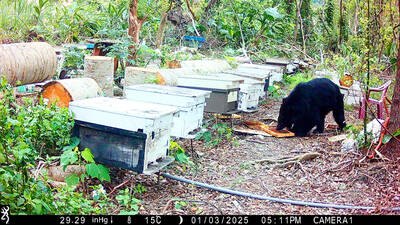A saxophone museum documenting the life of Taiwan’s first saxophone maker and the development of saxophone making in Houli District (后里), Greater Taichung, opened to the public yesterday.
The Chang Lien-cheng (張連昌) Saxophone Museum is named after a local resident who made the first saxophone in Taiwan on his own, sparking the development of the saxophone production industry in Houli, which is now one of the largest centers of saxophone production in the world.
TOURIST-FRIENDLY

Photo: CNA
Located in a town nicknamed “Musical Instrument Town,” the museum will display a collection of saxophones. Previously a memorial hall dedicated to Chang, the museum site now has a new two-story building, a concert hall and a tourist-friendly factory that allows visitors to see how the instrument is made.
“The museum is certainly not the only saxophone museum in Taiwan, but it is definitely the only one with a lot of stories to be shared,” Wang Tsai-jui (王彩蕊), Chang’s granddaughter-in-law, said in a telephone interview on Wednesday.
Chang, born in 1912, was a farmer’s son who abandoned the family’s farm to become a painter. He later joined a band when he was in his 20s.
“No one during the 1930s was actually playing any kind of Western instruments, but Chang was fascinated by the saxophone,” Wang said.
DETERMINED
When Chang’s saxophone was damaged in a fire, he was determined to build the brass tube by himself. He started from observing the shape of the instrument on canvas.
Three years into the making of the saxophone in 1948, he lost the sight in his right eye when a piece of copper flashed into his eyeball. However, the incident did not stop Chang from continuing his pursuit and the first locally made saxophone was finished shortly after the accident.
“The museum is really about showing the personality and perseverance of a person who loved music so much,” Wang said.
Chang trained a number of apprentices, helping saxophone making become a lucrative export industry for Taiwan from the 1950s to the 1990s. It’s no longer as profitable as it once was because of competition from China.
Two of the must-see saxophones in the museum are an intricately made instrument with a dragon decoration on the tube, specially made by Chang, and a 160-year-old saxophone produced by saxophone inventor Adolphe Sax, which was found and bought by Wang’s family through laborious trips to Belgium, Wang said.
FASCINATING
“We knew from the start that the museum is about more than showcasing the locally made instruments; we want to tell the very first story of this fascinating instrument,” Wang said.
Wang’s four daughters are all saxophone players.

SHIPS, TRAINS AND AUTOMOBILES: The ministry has announced changes to varied transportation industries taking effect soon, with a number of effects for passengers Beginning next month, the post office is canceling signature upon delivery and written inquiry services for international registered small packets in accordance with the new policy of the Universal Postal Union, the Ministry of Transportation and Communications said yesterday. The new policy does not apply to packets that are to be delivered to China, the ministry said. Senders of international registered small packets would receive a NT$10 rebate on postage if the packets are sent from Jan. 1 to March 31, it added. The ministry said that three other policies are also scheduled to take effect next month. International cruise ship operators

NUMBERS IMBALANCE: More than 4 million Taiwanese have visited China this year, while only about half a million Chinese have visited here Beijing has yet to respond to Taiwan’s requests for negotiation over matters related to the recovery of cross-strait tourism, the Tourism Administration said yesterday. Taiwan’s tourism authority issued the statement after Chinese-language daily the China Times reported yesterday that the government’s policy of banning group tours to China does not stop Taiwanese from visiting the country. As of October, more than 4.2 million had traveled to China this year, exceeding last year. Beijing estimated the number of Taiwanese tourists in China could reach 4.5 million this year. By contrast, only 500,000 Chinese tourists are expected in Taiwan, the report said. The report

The Forestry and Nature Conservation Agency yesterday launched a gift box to market honey “certified by a Formosan black bear” in appreciation of a beekeeper’s amicable interaction with a honey-thieving bear. Beekeeper Chih Ming-chen (池明鎮) in January inspected his bee farm in Hualien County’s Jhuosi Township (卓溪) and found that more than 20 beehives had been destroyed and many hives were eaten, with bear droppings and paw prints near the destroyed hives, the agency said. Chih returned to the farm to move the remaining beehives away that evening when he encountered a Formosan black bear only 20m away, the agency said. The bear

Chinese embassy staffers attempted to interrupt an award ceremony of an international tea competition in France when the organizer introduced Taiwan and displayed the Republic of China flag, a Taiwanese tea farmer said in an interview published today. Hsieh Chung-lin (謝忠霖), chief executive of Juxin Tea Factory from Taichung's Lishan (梨山) area, on Dec. 2 attended the Teas of the World International Contest held at the Peruvian embassy in Paris. Hsieh was awarded a special prize for his Huagang Snow Source Tea by the nonprofit Agency for the Valorization of Agricultural Products (AVPA). During the ceremony, two Chinese embassy staffers in attendance